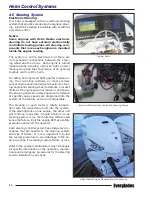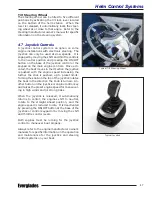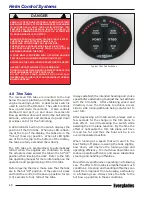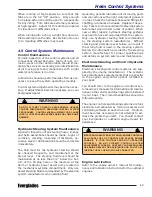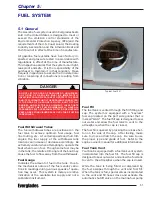
57
6.1 General
Your Everglades is equipped with 120 volt AC and
12 volt DC electrical systems. The AC system
can draw current from one of two sources, either
shore power outlets at dockside or the optional
generator. The DC system draws current from
onboard batteries.
Your boat and engine charging systems are de-
signed for 12 volt wet cell marine batteries, AGM
(Absorbed Glass Mat) or gel cell marine batter-
ies. AGM batteries are sealed, maintenance free
batteries.
All wires in the electrical systems are color coded
to make identifying circuits easier.
6.2 DC System Overview
The 12 volt system is a fairly standard marine
system. Your boat is equipped with four batter-
ies, one for each engine and two for the house,
generator and electronics. If your boat is equipped
with the optional SeaKeeper stabilizing system, it
will be equipped with 2 additional batteries dedi-
cated to that system.
The house and engine batteries are located in a
battery box below the passenger seat. The sys-
tem is controlled by three battery switches, one
for each engine and one for the house 12 volt
accessories, generator and the electronics. The
batteries are charged by the engines or a battery
charger when connected to shore power or when
the generator is operating.
If your boat is equipped with a Seakeeper, there
will be two batteries dedicated to that system
located in the compartment below the port com-
panion seat. The system is activated by a battery
switch and charged by a battery charger in the
compartment near the batteries.
Most 12 volt power is distributed to the 12 volt
accessories through individual fuses located in the
battery switch panel and fuse panels below the
helm. All circuit breakers and fuses are labeled
by the name of the circuit they protect.
Main circuit breakers near the battery switches
protect the primary circuits for the DC main,
electronics, windlass, sunshade and amplifiers.
Additional fuses near the main circuit breakers
protect continuous power circuits for the stereo
memory, automatic switches for bilge pumps,
shower sump automatic switch, CO monitors, the
helm battery switches and the carbon monoxide
monitors.
Most 12 volt accessories are operated directly by
switches in the helm switch panel, cockpit or the
cabin. Most accessory circuits are protected by
fuses in fuse panels near the battery switches.
Main breakers or fuses located on each engine pro-
tect the ignition systems and gauge panel display.
Yamaha engine electrical circuits are protected by
fuses located in a fuse panel on the side of the
engine. The fuse panel is equipped with a spare
fuse for each circuit. Always replace fuses used
with the fuse specified by Yamaha or your engine
manufacturer. Refer to the engine owner’s manual
for more information on the fuses, fuse panels or
circuit breakers on your engines.
CAUTION
PROPER FUSE OR BREAKER PROTECTION MUST BE
PROVIDED FOR ALL 12 VOLT EQUIPMENT ADDED. DO
NOT OVERLOAD THE ACCESSORY CIRCUIT BREAKERS
OR OTHER CIRCUITRY THROUGH ADDITIONAL 12 VOLT
EQUIPMENT.
Chapter 6:
ELECTRICAL SYSTEM
Summary of Contents for 340 DC
Page 1: ...OWNER S MANUAL 340 DC...
Page 2: ...2 Revision 0 11 07 2018...
Page 14: ...14 NOTES...
Page 22: ...22 NOTES...
Page 25: ...25 Operation...
Page 86: ...86 NOTES...
Page 102: ...102 NOTES...
Page 122: ...122 NOTES...
Page 130: ...130 NOTES...
Page 149: ...149 MAINTENANCE LOG Appendix B Hours Date Dealer Service Repairs...
Page 150: ...150 Maintenance Log Hours Date Dealer Service Repairs...
Page 151: ...151 Maintenance Log Hours Date Dealer Service Repairs...
Page 152: ...152 Maintenance Log Hours Date Dealer Service Repairs...
Page 153: ...153 Maintenance Log Hours Date Dealer Service Repairs...
Page 154: ...154 Maintenance Log Hours Date Dealer Service Repairs...
Page 155: ...155 Appendix C BOATING ACCIDENT REPORT...
Page 156: ...156 Boating Accident Report...
Page 157: ...157 Boating Accident Report...
Page 158: ...158 NOTES...
Page 160: ...160 NOTES...
Page 167: ...CAUSE AND SOLUTION...




